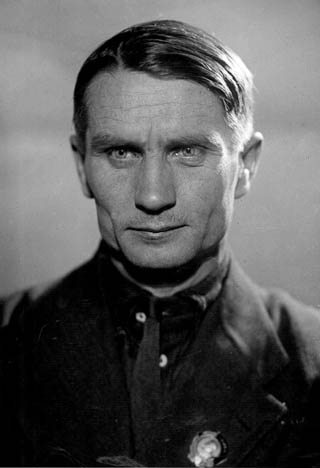Lysenko, Trokhym
Lysenko, Trokhym [Лисенко, Трохим; Lysenko, Troxym], b 29 September 1898 in Karlivka, Kostiantynohrad county, Poltava gubernia, d 20 November 1976 in Moscow. Agronomist and agrobiologist; full member of the Academy of Sciences of the Ukrainian SSR from 1934 and the USSR Academy of Sciences from 1939; head of the Michurinist trend in Soviet biology. Lysenko attended horticultural schools in Poltava (1913) and Uman (1917–20) and studied agronomy at the Kyiv Agricultural Institute (1921–5). He rose to prominence in 1925–9 while posted in Azerbaidzhan, by publishing an article (1928) on the relationship between cold temperature and late ripening, suggesting that it was possible to produce desirable characteristics by manipulating growing conditions. He experimented with winter wheat on his father’s farm (1928–9) by burying germinating seeds in snow, and this measure reportedly led to greatly increased yields. Lysenko termed this procedure ‘vernalization’ (yarovizatsiia; Ukr: yarovyzatsiia), and in 1929 he was given a laboratory in the plant physiology division of the All-Union Institute of Selection and Genetics in Odesa. To popularize his work, in 1931 the USSR Ministry of Agriculture created the journal Biullete'’ iarovizatsii (renamed Iarovizatsiia in 1935, Agrobiologiia in 1946).
During the heyday of Soviet ‘vernalization’ (1929–35) Lysenko devised similar techniques and applied them to a wide range of vegetables, fruits, and grains. He and his supporters made extravagant claims for the efficacy of his techniques, and ‘vernalization’ was reportedly used for many millions of hectares of crop cultivation in the early 1930s. For this work, in 1934 Lysenko became scientific director of the All-Union Institute of Selection and Genetics in Odesa and a full member of the All-Ukrainian Academy of Sciences. He led similar campaigns for the summer planting of potatoes (1935) and maize (1956), for grafting or ‘vegetative hybridization’ (late 1930s), for the ‘grassland system’ of planting (1939–52) and the ‘cluster method’ of forestation (1948–52) (see Forest management), and for increasing the butterfat content in milk (1958–62).
In 1935 Lysenko joined forces with the Leningrad lawyer and philosopher I. Prezent and began to elaborate his agronomic practices into a theoretical framework with heavy ideological content. In pamphlets the two asserted that, with alteration in the conditions at the end of a developmental stage, the heredity of a plant could be destabilized or ‘cracked,’ and the plant thereby rendered plastic and malleable. Following the death of the plant breeder Ivan Michurin in 1935, Lysenko declared himself the heir to Michurin’s tradition and named his own approach ‘Michurinist biology,’ as a contrast to the approach of G. Mendel and A. Weismann’s genetics, a ‘bourgeois capitalist science.’ Lysenko was a member of the USSR government’s Central Executive Committee (1935–7) and assistant to the president of the council of the Supreme Soviet of the USSR (1937–50).
In 1935 Nikolai Vavilov was removed as president of the All-Union Academy of Agricultural Sciences (VASKhNIL), and Lysenko was elected a full member; the next year he was put in charge of its Odesa Institute. Lysenko assumed the president’s post of VASKhNIL in 1938 and held it for almost two decades. With the help of the NKVD he used his position to harass and undermine Vavilov’s supporters. After Vavilov’s arrest in August 1940, Lysenko left Odesa to replace him as director of the academy’s Institute of Genetics in Moscow, a post he held until 1965.
In 1948–9 the massive Soviet reforestation program made use of Lysenko’s cluster method of planting and sustained extensive losses. Lysenko was forced to resign as president of VASKhNIL in 1956. By late 1958 he had embraced Nikita Khrushchev’s agricultural policy, and he gained influence in the subsequent development of Khrushchev’s agricultural program. In 1961–2 Lysenko was again briefly president of VASKhNIL. After Khrushchev’s ouster a joint commission of the Ministry of Agriculture and the two academies investigated Lysenko’s Lenin Hills experimental farm. It concluded that his experimental work had been carried out and tested improperly, and that all of his agricultural techniques were either ineffective or harmful. Lysenko was removed as director of the Institute of Genetics (1965), and it was officially disbanded, but he kept control of his Lenin Hills farm until his death.
BIBLIOGRAPHY
Huxley, Julius. Heredity East and West (New York 1949)
Zirkle, Conway. (ed). Death of a Science in Russia (Philadelphia 1949)
Safonov, V. Land in Bloom (Moscow 1951)
Zirkle, Conway. Evolution, Marxian Biology, and the Social Scene (Philadelphia 1959)
Medvedev, Zhores. The Rise and Fall of T.D. Lysenko (New York 1969)
Joravsky, David. The Lysenko Affair (Cambridge, Mass 1970)
Lecourt, Dominique. Lyssenko: Histoire réelle d’une ‘science prolétarienne’ (Paris 1976)
Buican, Denis. L’éternel retour de Lyssenko (Paris 1978)
Regelmann, Johann-Peter. Die Geschichte des Lyssenkoismus (Frankfurt 1980)
Popovsky, Mark. The Vavilov Affair (Hamden, Conn 1984)
Roll-Hansen, Nils. Onsketenkning som vitenskap: Lysenkos innmarsji sovjetisk biologii, 1927–37 (Oslo 1985)
Mark Adams
[This article originally appeared in the Encyclopedia of Ukraine, vol. 3 (1993).]
